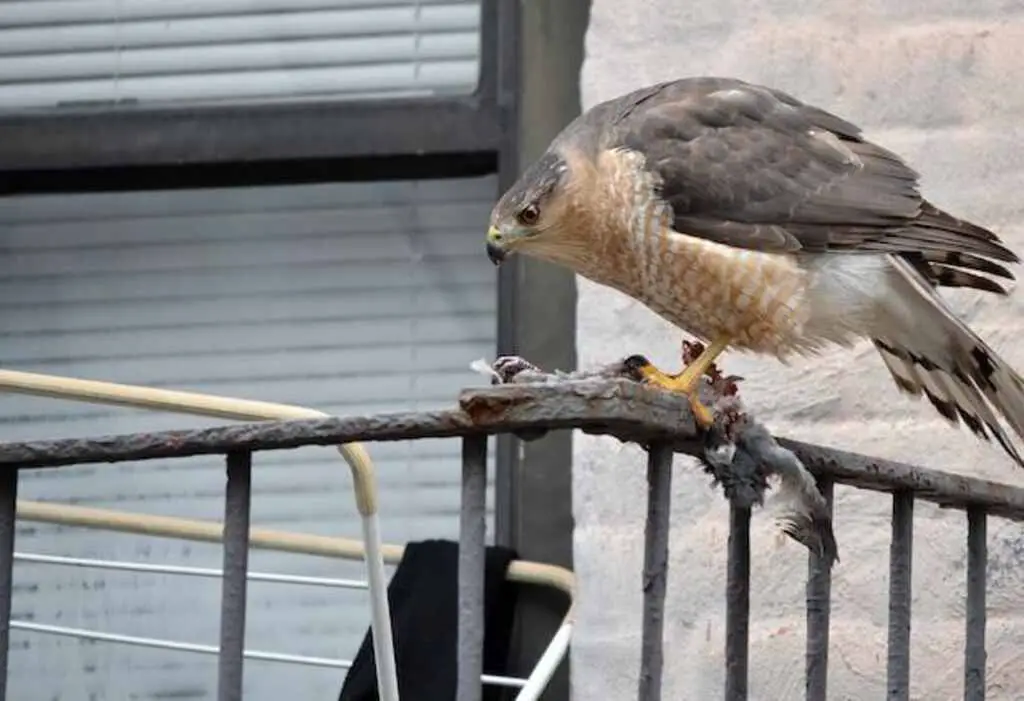Explore the fascinating world of avian predators as we delve into the question: do hawks feast on pigeons? Uncover the intricate dynamics of bird predation and discover the truth behind this intriguing ecological interaction.
Table of Contents
- 1 Hawks and Pigeons: A Predatory Connection
- 2 A Brief Overview of Hawks and Their Diet
- 3 Why People are Curious About Whether Hawks Eat Pigeons
- 4 Do Hawks Eat Pigeons?
- 5 Hawk Species That Eat Pigeons
- 6 The Nutritional Value of Pigeons for Hawks
- 7 Hawk-Pigeon Interaction in Urban Areas
- 8 The Role of Hawks in Controlling Pigeon Populations
- 9 Conclusion
- 10 FAQs: Do Hawks Eat Pigeons?
- 10.1 Are pigeons a primary food source for hawks?
- 10.2 How do hawks capture pigeons?
- 10.3 Do hawks hunt pigeons in urban areas?
- 10.4 Do hawks eat pigeons whole?
- 10.5 How important are pigeons in a hawk’s diet?
- 10.6 Are there specific hawk species that specialize in hunting pigeons?
- 10.7 Do hawks have any natural predators?
- 10.8 Do hawks pose any risks to humans or pets?
- 10.9 How can one identify if a hawk has preyed on a pigeon?
- 10.10 What is the ecological importance of hawks hunting pigeons?
- 11 Author
Hawks and Pigeons: A Predatory Connection
Hawks are majestic birds of prey that can be found all over the world, from deserts to forests, and even in urban environments.
These fierce predators have long been the focus of human fascination due to their incredible hunting skills and impressive aerial displays.
But what exactly do hawks eat? Are these birds capable of attacking and killing pigeons?
The diet of hawks varies depending on their species, habitat, and other environmental factors.
Generally speaking, hawks are carnivorous predators that feed on a wide variety of prey, including small mammals, reptiles, insects, and birds.
Some species of hawks are known to specialize in hunting certain types of prey, such as snakes or rodents.
Despite the diverse range of prey items available to them, many people wonder if hawks will attack pigeons.
This is primarily because pigeons are one of the most common bird species found in urban areas around the world.
As such, many people have observed hawks flying in urban environments and wondered whether they pose a threat to local pigeon populations.
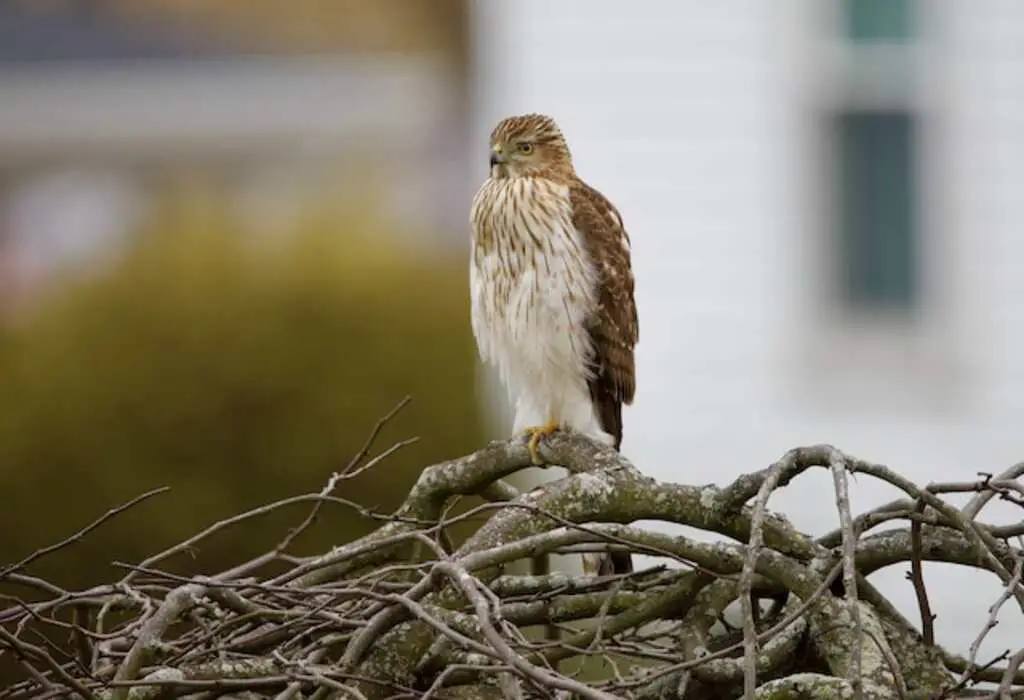
A Brief Overview of Hawks and Their Diet
Hawks belong to the family Accipitridae which includes other birds of prey like eagles, kites, and harriers. There are more than 250 species of hawks worldwide, with varying sizes ranging from 10 inches (25 cm) up to 30 inches (76 cm).
They have sharp talons for grasping prey firmly, while their hooked beaks help them tear into flesh.
Hawks primarily feed on live animals which they capture using different hunting techniques such as soaring from high altitudes then diving at their unsuspecting victims with incredible speed or stalking on foot before rushing toward their target with lightning-fast movements.
The size and type of prey that hawks consume vary depending on the species of hawk, their geographic location and niche. Some hawks feed primarily on rodents, while others eat reptiles, snakes and insects.
Larger birds such as eagles can even take down larger prey such as deer or monkeys.
Despite their varied diet, many people are still curious about whether hawks eat pigeons due to the prevalence of these birds in urban areas around the world.
Why People are Curious About Whether Hawks Eat Pigeons
Pigeons are one of the most common bird species found in urban environments around the world. They have adapted well to living among humans and thrive in cities thanks to the abundance of food scraps and other resources that people often discard.
As a result, many people have observed hawks flying in urban areas where pigeons often congregate and wondered whether these majestic birds of prey pose a threat to local pigeon populations.
Additionally, there is a natural human curiosity about what different animals eat and how they interact with each other in the wild.
Understanding whether hawks will attack pigeons is not just a matter of scientific curiosity, but also has practical implications for wildlife management programs aimed at controlling pigeon populations in urban environments.
As such, it is important to investigate this topic further by examining which hawk species are known to eat pigeons, how hawks hunt their prey and looking at nutritional benefits that pigeons provide for hawks.
Do Hawks Eat Pigeons?
Yes, hawks do eat pigeons. Hawks are skilled predators known for their diverse diet, which includes pigeons. They employ various hunting techniques and adaptations to capture and consume pigeons in both rural and urban environments.
Pigeons provide nutritional value to hawks, offering essential proteins and other nutrients. This predator-prey relationship plays an important role in controlling pigeon populations and maintaining ecological balance.
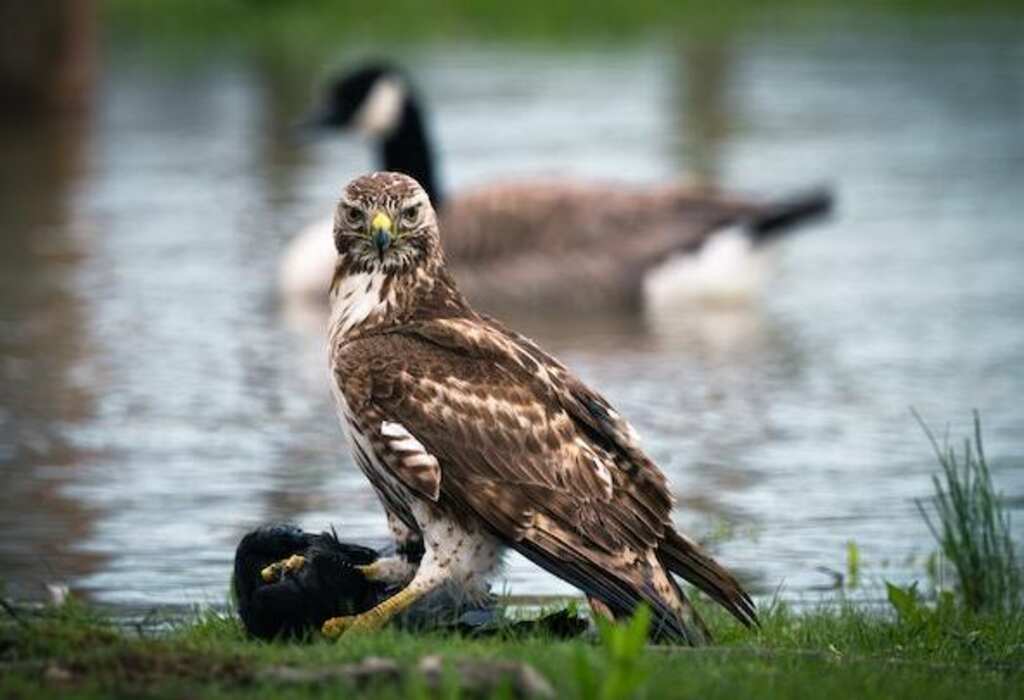
Hawk Species That Eat Pigeons
Hawks are powerful birds of prey with a keen sense of vision and excellent hunting skills. There are several different species of hawks that have been observed preying on pigeons.
These include the Cooper’s hawk, the sharp-shinned hawk, and the red-tailed hawk.
Cooper’s hawks are medium-sized birds that prefer to hunt in wooded areas, where they can use trees as cover while they stalk their prey.
They have a distinctive flap-and-glide hunting style, where they fly quickly through the trees before suddenly dropping down onto their prey from above.
Cooper’s hawks have been known to take on pigeons as large as themselves.
Sharp-shinned hawks are smaller than Cooper’s hawks, but still pack a powerful punch when it comes to hunting.
They are agile hunters that can fly through dense foliage with ease, making them well-suited for woodland environments where pigeons often roost.
Sharp-shinned hawks use surprise attacks to catch their prey, darting out from cover at high speed before striking with their razor-sharp talons.
Red-tailed hawks are larger birds than either Cooper’s or sharp-shinned hawks and tend to hunt in more open areas such as fields and meadows.
They rely primarily on their incredible eyesight to spot their prey from great distances before swooping down upon it in a dramatic display of aerial prowess.
Red-tailed hawks generally prefer small mammals such as rodents or rabbits, but will also take pigeons if given the opportunity.
Details on the Hunting Techniques Used by These Hawks
The various species of hawk that predate upon pigeons each have their unique hunting techniques which enable them to capture these elusive birds.
Cooper’s hawks rely heavily on stealth and speed when hunting pigeons; using tree cover for disguise, they fly into a clearing at high speed, surprising their prey before quickly pouncing on them.
These hawks have a reputation for being particularly skilled at catching fast-moving prey like pigeons, which require a high degree of accuracy and precision when targeting.
Sharp-shinned hawks, on the other hand, use agility to catch pigeons.
They are nimble birds that can fly through tight spaces with ease, making them well-suited for navigating the complex architecture of urban environments where pigeons often roost.
They rely heavily on their quickness and evasive maneuvers to keep their prey off-balance before finally swooping in for the kill.
Red-tailed hawks favor an aerial approach when hunting pigeons.
These majestic birds are skilled at soaring through open skies, using their keen vision to spot prey from great distances before diving towards it in a powerful stoop.
Once in range of their target, red-tailed hawks strike with incredible force and accuracy, immobilizing their prey with sharp talons before delivering the killing blow.
Hawks, with their diverse species, employ various strategies and techniques to capture both domestic and wild pigeons.
Their remarkable efficiency as hunters contributes to the ecological balance by controlling pigeon populations in both urban and rural environments.
These raptors play a crucial role in maintaining harmony in nature.
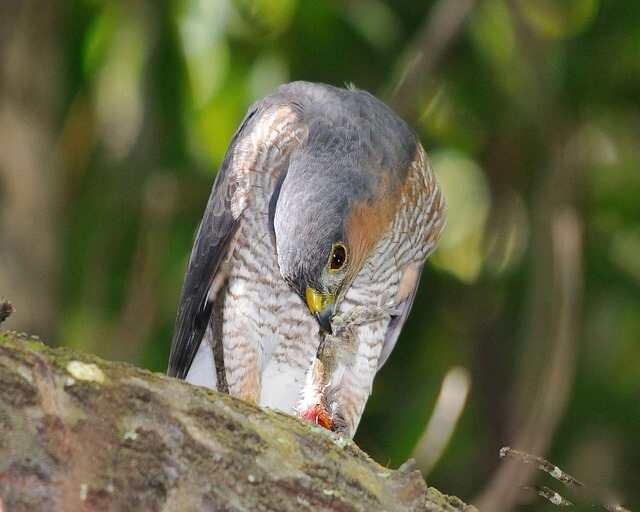
The Nutritional Value of Pigeons for Hawks
Hawks prey on a wide variety of animals, including rodents, rabbits, snakes, and birds. However, pigeons are one of the most common types of bird preyed upon by hawks.
Not only are pigeons abundant in many areas, but they also provide a significant amount of nutritional value to hawks.
The Role of Protein in a Hawk’s Diet
Protein is essential for the growth and maintenance of body tissues. Hawks require high levels of protein to maintain their flight muscles and other organs necessary for successful hunting and survival in the wild.
Pigeons are an excellent source of protein for hawks. In fact, approximately 90% of a pigeon’s dry weight is made up of protein.
Other Nutrients Found in Pigeons
In addition to protein, pigeons contain several other nutrients that are essential for a hawk’s health and survival. For example, like all birds, pigeons have a high concentration of calcium in their bones. Hawks need calcium to maintain strong bones and eggshells.
Pigeons also contain significant amounts of fat and other important nutrients such as vitamins A and B12.
Fat is an essential component in the diet because it provides energy required for flight as well as insulation against cold temperatures.
Hunter’s Digestion: The Importance of Nutrient Absorption
Hawks’ digestive systems have evolved to optimize nutrient absorption from their prey items efficiently. They have short intestines that allow them to quickly process food before it begins to spoil or loses its nutritional value.
The hawk’s digestive system consists of two key regions: the proventriculus, or glandular stomach, breaks down food chemically and secretes enzymes.
The food is then passed on to the gizzard, where it undergoes mechanical grinding. This efficient process allows hawks to extract the maximum amount of nutrients from their food.
The Importance of a Diverse Diet for Hawks
While pigeons are a valuable source of nutrition for hawks, it is important to note that hawks require a diverse diet to maintain optimal health.
Relying too heavily on one type of prey can lead to nutritional deficiencies, which can negatively affect a hawk’s health and ability to hunt.
Therefore, while pigeons may be a significant part of a hawk’s diet in some areas, they are just one piece of the puzzle when it comes to ensuring the health and survival of these majestic birds.

Hawk-Pigeon Interaction in Urban Areas
How Urbanization has Affected Hawk-Pigeon Interactions
Hawks have adapted to living in cities due to the increasing urbanization worldwide.
The expansion of cities has created new habitats for hawks, and they have learned to use the structures and spaces available in these environments for hunting prey.
Hawks that live in urban areas are known to prey on pigeons more often than those that live in rural areas.
Due to the abundance of pigeons available in urban areas, hawks have learned how to hunt them effectively.
The increase in human activities such as construction work, traffic noise, and air pollution has had some effects on hawk-pigeon interactions.
The noise from vehicles and machinery can scare away both pigeons and hawks from their typical habitats.
This can affect a hawk’s ability to hunt its prey effectively, since they rely heavily on their keen eyesight and hearing abilities.
Details on How Hawks Have Adapted to Urban Environments and Learned To Hunt Pigeons In Cities
Hawks that live in urban environments have adapted their hunting techniques accordingly.
Since there are fewer open spaces for them to soar above their prey before attacking, hawks have learned how to stalk pigeons while perched on buildings or other structures.
They also take advantage of any trees or tall structures they can find near open areas where pigeons can be found.
Urban hawks are also known for using surprise attacks when hunting pigeons.
They will often fly low over a group of unsuspecting pigeons before swooping down quickly for a surprise attack from above or behind, catching the pigeon off guard.
In addition, some hawk species such as the Cooper’s hawk have adapted by becoming more agile flyers, such as chasing after its prey through narrow alleys between buildings where it is easier for them to catch smaller birds like pigeons.
Overall, hawks have proven to be highly adaptable animals capable of surviving and thriving in various habitats, including urban environments.
Their ability to adapt their hunting techniques to prey available in cities is a testament to their intelligence and resourcefulness.
As the world continues its urbanization trend, we can expect hawks and other wildlife species to continue adapting in order to survive.
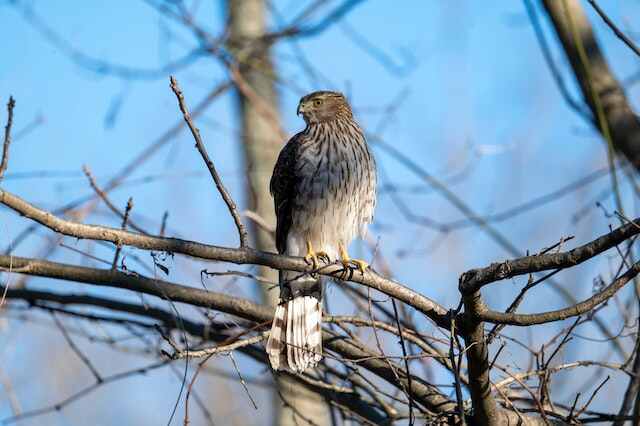
The Role of Hawks in Controlling Pigeon Populations
How Hawks Help Regulate Pigeon Populations
Hawks play an important role in the natural regulation of pigeon populations. By preying on pigeons, hawks help control their numbers, thus preventing overpopulation and maintaining a balance in the ecosystem.
Additionally, hawks are efficient hunters that can catch multiple pigeons per day, which helps to keep pigeon populations in check.
However, it’s important to note that while hawks do play a role in regulating pigeon populations, they are not the only factor at play. Other predators and environmental factors also contribute to population control.
Examination of the Ecological Importance of this Relationship
The relationship between hawks and pigeons is not just important for population control; it also has ecological significance. Hawks are top predators that occupy an important place in the food chain.
By preying on pigeons, they help maintain a healthy ecosystem by controlling both pigeon numbers and behavior. Additionally, this relationship can have ripple effects throughout the food chain.
For example, if there are too many pigeons competing for resources such as food or nesting sites, other bird species may suffer as well.
By regulating pigeon populations, hawks indirectly contribute to the health and survival of other bird species as well.
Conclusion
Understanding hawk-pigeon interactions is important for both ecological reasons and practical purposes such as urban planning.
While some people may view hawks as pests or threats to human safety due to their tendency to hunt near populated areas, it’s important to appreciate their role in maintaining a healthy ecosystem.
Furthermore, by understanding this relationship between predator and prey, we can better manage urban environments where these interactions occur frequently.
Through careful planning and education about hawk behavior and ecology, we can ensure that both humans and wildlife can coexist peacefully.
Ultimately, the relationship between hawks and pigeons demonstrates the delicate balance of nature and the important role that each species plays in maintaining a healthy ecosystem.
By appreciating this balance, we can work towards a more sustainable future for both ourselves and the natural world.
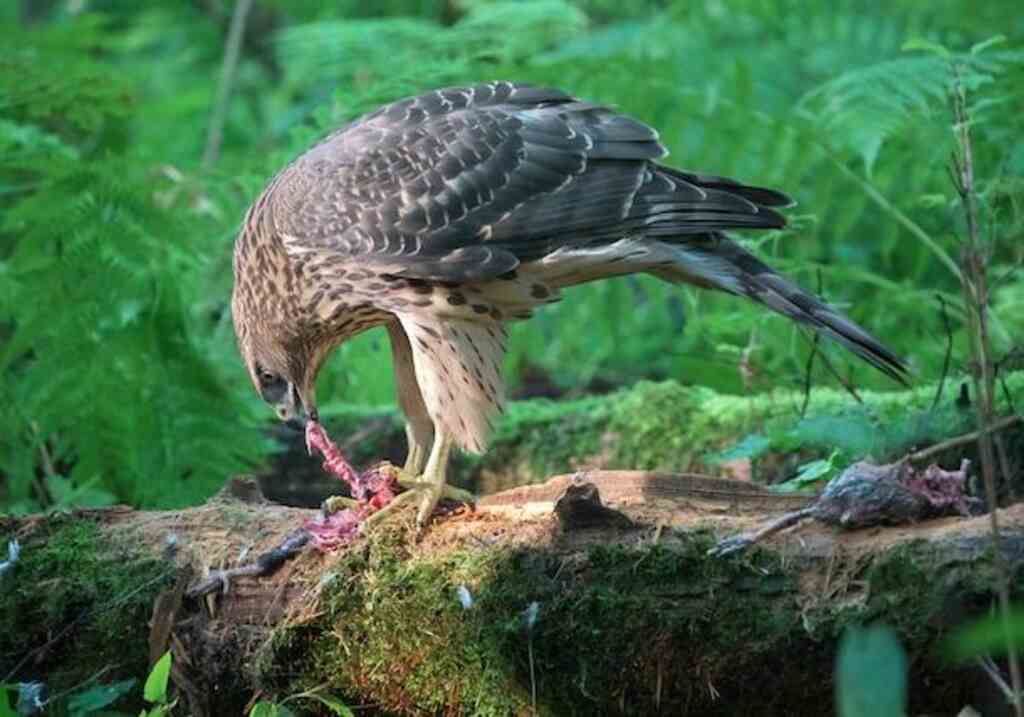
FAQs: Do Hawks Eat Pigeons?
Are pigeons a primary food source for hawks?
Pigeons are a common prey item for hawks, but they are not their sole or primary food source. Hawks have a diverse diet and hunt a variety of small to medium-sized birds, mammals, and other prey.
How do hawks capture pigeons?
Hawks employ various hunting techniques to capture pigeons. They use their speed, agility, and sharp talons to swoop down on unsuspecting pigeons or chase them in flight, ultimately capturing them for consumption.
Do hawks hunt pigeons in urban areas?
Yes, hawks have adapted to urban environments and often hunt pigeons in cities. Urban areas provide ample food sources and perching locations for hawks, making pigeons a readily available prey option.
Do hawks eat pigeons whole?
Hawks typically consume pigeons by tearing them apart with their beaks and swallowing smaller pieces. They may remove feathers or pluck certain parts before eating, but they generally do not eat pigeons whole.
How important are pigeons in a hawk’s diet?
Pigeons hold nutritional value for hawks, offering proteins and other essential nutrients. While not exclusive to their diet, pigeons contribute to a balanced and varied food intake for hawks.
Are there specific hawk species that specialize in hunting pigeons?
Certain hawk species, such as the Peregrine Falcon and Cooper’s Hawk, are known for their proficiency in hunting pigeons. These species have adapted their hunting techniques and behaviors to efficiently capture and consume pigeons.
Do hawks have any natural predators?
Hawks have few natural predators due to their aerial prowess and sharp talons. However, larger raptors like eagles and owls can pose a threat to hawks, particularly during territorial disputes or competition for food.
Do hawks pose any risks to humans or pets?
Hawks generally avoid human interaction and pose minimal risks to humans or pets. They prefer to hunt and feed on wild prey, but occasional conflicts may arise if hawks feel threatened or disturbed near their nesting sites.
How can one identify if a hawk has preyed on a pigeon?
Signs of a hawk preying on a pigeon may include scattered feathers, remains of the prey, and distinctive talon marks on the pigeon’s body. Observing the predatory behavior or witnessing the hunt can also indicate hawk involvement.
What is the ecological importance of hawks hunting pigeons?
Hawks play a crucial role in controlling pigeon populations, particularly in urban areas where pigeons can become overabundant. By regulating pigeon numbers, hawks help maintain ecological balance and mitigate potential issues associated with excessive pigeon populations.

